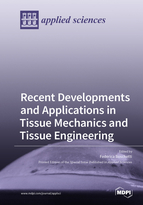Recent Developments and Applications in Tissue Mechanics and Tissue Engineering
A special issue of Applied Sciences (ISSN 2076-3417). This special issue belongs to the section "Applied Biosciences and Bioengineering".
Deadline for manuscript submissions: closed (20 August 2021) | Viewed by 15960
Special Issue Editor
Interests: health; biomedical engineering; biomechanics; biofluid-dynamics; bioengineering; bioreactors for tissue engineering; drug delivery; medical devices and endoprostheses; tissue mechanics
Special Issues, Collections and Topics in MDPI journals
Special Issue Information
Dear Colleagues,
Tissue mechanics and tissue engineering are multidisciplinary and interconnected fields, studied at multiple scales by integrating the knowledge in biology, solid mechanics, fluid dynamics, finite element modeling, imaging, electronics, automation, and design. Experimental, computational, and combined approaches are often used to investigate the structure–function relationships in tissues and to understand how their mechanics and biological pathways are altered in injury, disease, and regeneration.
The objective of this Special Issue is to present recent methods to investigate tissue mechanics or tissue engineering, or combined research between the two fields. These methods may include novel approaches such as recent technologies, new experimental setups and protocols, or novel combined experimental-numerical methods, applied to extensively studied tissues or established techniques applied to unusual tissues or tissue-engineered constructs.
Recent Developments and Applications in Tissue Mechanics and Tissue Engineering will be crucial to design reliable prostheses and implants, to predict surgical outcome after specific interventions, and for the reconstruction and regeneration of diseased or injured tissues and organs.
Prof. Dr. Federica Boschetti
Guest Editor
Manuscript Submission Information
Manuscripts should be submitted online at www.mdpi.com by registering and logging in to this website. Once you are registered, click here to go to the submission form. Manuscripts can be submitted until the deadline. All submissions that pass pre-check are peer-reviewed. Accepted papers will be published continuously in the journal (as soon as accepted) and will be listed together on the special issue website. Research articles, review articles as well as short communications are invited. For planned papers, a title and short abstract (about 100 words) can be sent to the Editorial Office for announcement on this website.
Submitted manuscripts should not have been published previously, nor be under consideration for publication elsewhere (except conference proceedings papers). All manuscripts are thoroughly refereed through a single-blind peer-review process. A guide for authors and other relevant information for submission of manuscripts is available on the Instructions for Authors page. Applied Sciences is an international peer-reviewed open access semimonthly journal published by MDPI.
Please visit the Instructions for Authors page before submitting a manuscript. The Article Processing Charge (APC) for publication in this open access journal is 2400 CHF (Swiss Francs). Submitted papers should be well formatted and use good English. Authors may use MDPI's English editing service prior to publication or during author revisions.
Keywords
- Tissue mechanics
- Tissue engineering
- Structure–function relationships
- Experimental testing
- Computational modeling
- 3D bioprinting
- Biomaterials
- Biomechanical testing






